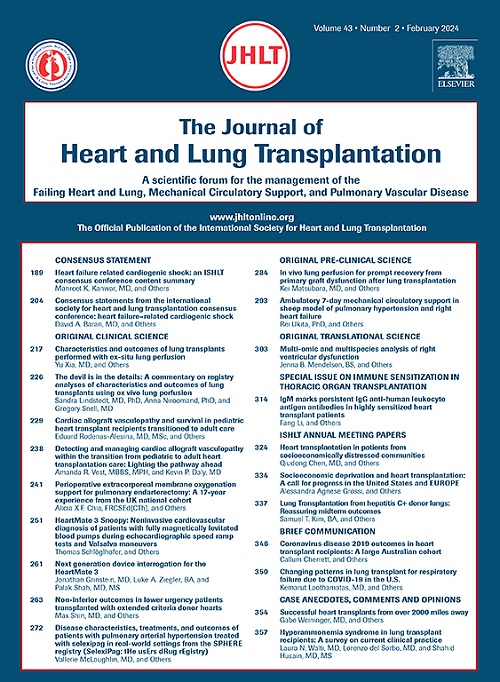Heart transplantation in Ukraine during wartime: A retrospective cohort study of standard vs marginal donor heart transplantation outcomes
IF 6
1区 医学
Q1 CARDIAC & CARDIOVASCULAR SYSTEMS
引用次数: 0
Abstract
Background
Heart transplantation (HTx) is the gold standard for end-stage heart failure treatment, yet donor shortages limit its availability. In Ukraine, legislative reforms in 2019 spurred HTx growth, but the ongoing war halted progress and disrupted logistics. This study evaluates outcomes of orthotopic HTx, focusing on use of marginal donor hearts to expand the traditional donor pool.
Methods
We conducted a retrospective cohort study of 106 consecutive HTx cases at the Heart Institute of the Ministry of Health of Ukraine from December 2019 to October 2024. Data included donor and recipient characteristics, surgical details, complications, and survival. Marginal donors were defined by criteria such as age >55 years, ischemic time >240 minutes, or weight mismatch. Outcomes were compared between standard (n = 67) and marginal (n = 39) donor groups using Kaplan-Meier survival analysis and nonparametric tests.
Results
Median donor and recipient age were 47 and 48.5 years, respectively; 36.7% of donors were marginal. Median ischemic time was 80 minutes, similar between groups (p = 0.554). Postoperative complications (e.g., primary graft dysfunction, 10.4%) and survival (1-year: 87.7%, 2-year: 86.7%) showed no significant differences between groups (log-rank p = 0.709). Marginal donors increased the donor pool by ∼40%.
Conclusions
Utilizing marginal donor hearts in Ukraine’s HTx program expanded organ availability without compromising outcomes, offering a viable strategy amidst war-related challenges.
战时乌克兰的心脏移植:标准供体与边缘供体心脏移植结果的回顾性队列研究。
背景:心脏移植(HTx)是终末期心力衰竭治疗的金标准,但供体短缺限制了其可用性。在乌克兰,2019年的立法改革刺激了HTx的增长,但持续的战争阻碍了进展,扰乱了物流。本研究评估了原位HTx的结果,重点是使用边缘供体心脏来扩大传统的供体池。方法对2019年12月至2024年10月乌克兰卫生部心脏研究所连续106例HTx病例进行回顾性队列研究。数据包括供体和受体特征、手术细节、并发症和生存率。边际供体的定义标准为年龄bbbb55岁,缺血时间bbbb240分钟,或体重不匹配。使用Kaplan-Meier生存分析和非参数检验比较标准(n=67)和边缘(n=39)供体组的结果。结果供体和受体的中位年龄分别为47岁和48.5岁;36.7%的捐赠者属于边缘人群。中位缺血时间为80分钟,组间差异无统计学意义(p=0.554)。术后并发症(如原发性移植物功能障碍,10.4%)和生存率(1年:87.7%,2年:86.7%)组间差异无统计学意义(log-rank p=0.709)。边际捐助者使捐助者池增加了约40%。结论:在乌克兰的HTx项目中,利用边缘供体心脏扩大了器官的可用性,同时又不影响结果,为应对战争相关挑战提供了一种可行的策略。
本文章由计算机程序翻译,如有差异,请以英文原文为准。
求助全文
约1分钟内获得全文
求助全文
来源期刊
CiteScore
10.10
自引率
6.70%
发文量
1667
审稿时长
69 days
期刊介绍:
The Journal of Heart and Lung Transplantation, the official publication of the International Society for Heart and Lung Transplantation, brings readers essential scholarly and timely information in the field of cardio-pulmonary transplantation, mechanical and biological support of the failing heart, advanced lung disease (including pulmonary vascular disease) and cell replacement therapy. Importantly, the journal also serves as a medium of communication of pre-clinical sciences in all these rapidly expanding areas.

 求助内容:
求助内容: 应助结果提醒方式:
应助结果提醒方式:


